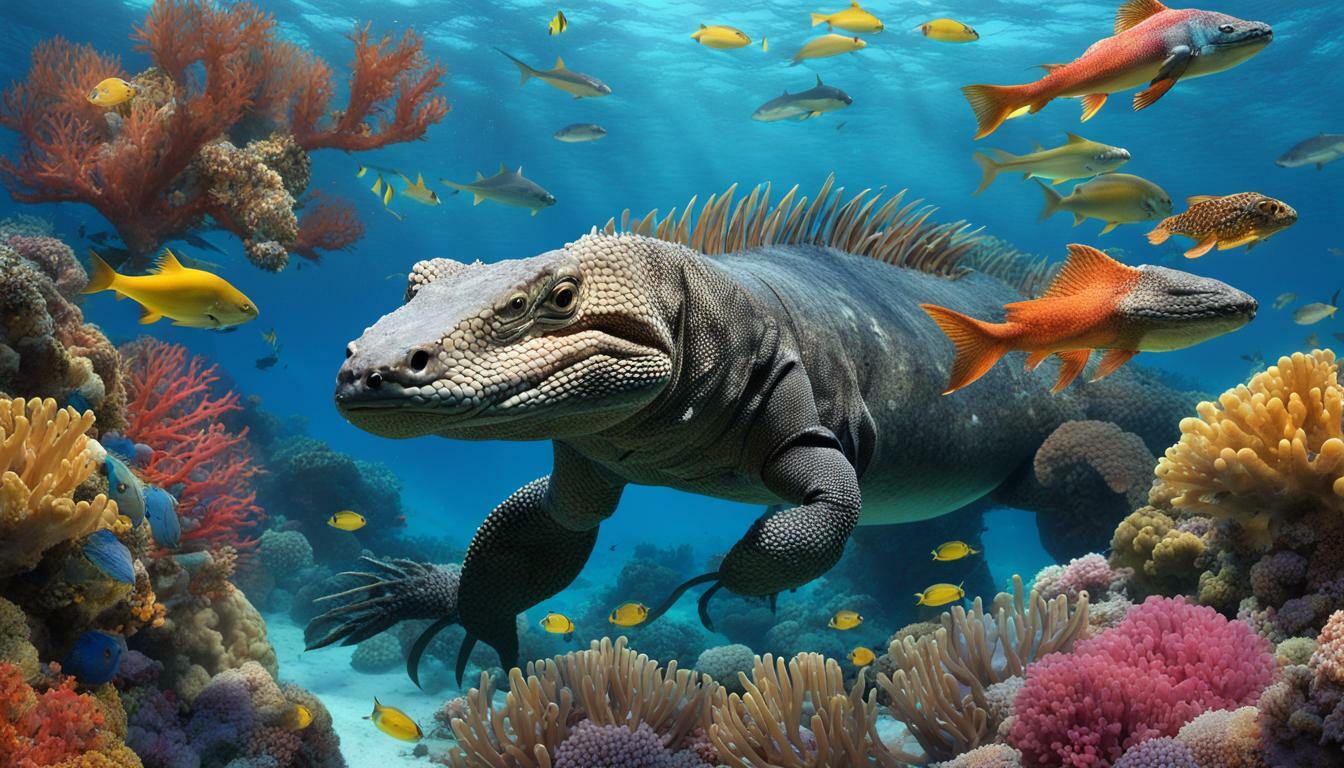Can Komodo Dragons Swim? Discovering Reptile Capabilities

Table of content:
The Komodo dragon is a large species of lizard found on several Indonesian islands. These huge reptiles are known for their deadly venom and ability to take down prey much larger than themselves. But can these stealthy predators also swim?
Do Komodo Dragons Swim?
Yes, Komodo dragons are able to swim and have been observed doing so on occasion. However, they are not very strong swimmers compared to other aquatic reptiles like crocodiles.
Komodo dragons will enter the water to hunt prey or escape threats on land. They have been seen paddling short distances between islands. But they prefer to avoid swimming and are not built for lengthy open ocean crossings.
Why Don’t Komodo Dragons Swim Often?
There are a few key reasons why Komodo dragons do not swim frequently:
- Buoyancy – Their large size and weight makes it difficult for them to float well on the surface. They lack adaptations for buoyancy like fat stores or air sacs.
- Terrestrial lifestyle – Komodos are primarily land animals. Their bodies are built for walking and running, not swimming. They prefer to hunt and feed on land.
- Energy use – Swimming takes a lot of energy. Komodos rely on lying in wait to ambush prey rather than chasing it down. So they conserve their energy.
- Water scarcity – On the arid islands they inhabit, bodies of water are a scarce resource. Komodos do not encounter water frequently in their natural range.
How Well Can Komodo Dragons Swim?
Komodo dragons are capable swimmers for short distances. Using their strong legs and muscular tail, they can propel themselves through the water at a steady pace.
During swimming, they keep their nostrils on the surface so they can breathe. Their scales and skin protect them from water exposure. Powerful clawed feet aid in paddling and steering.
Most Komodos can swim steadily for 15-20 minutes before tiring. Exceptional individuals have been recorded swimming over 400 meters continuously. But such extended swims are rare outside captivity.
Overall their swimming abilities are limited compared to specialized aquatic reptiles. They lack adaptations like webbed feet or lateral undulation seen in crocodilians and sea turtles.
Do Baby Komodo Dragons Swim?
Baby Komodo dragons, known as hatchlings, can swim immediately after hatching if needed. Their instincts drive them to paddle and keep their head above water.
Young Komodos seem to swim quite readily in captivity. Wild hatchlings may also enter the water to escape predators on land. But the lack of observed swimming in the wild means it likely does not come naturally to them.
As they grow older and larger, juvenile Komodos tend to avoid swimming and spend more time in trees. Their increasing size makes buoyancy and paddling more difficult.
Can Young Komodo Dragons Swim?
Young Komodo dragons up to 3-4 years old are still capable swimmers. Their smaller size enables them to stay buoyant and paddle effectively.
Young komodos have been observed swimming in the wild on rare occasions. Their arboreal tendencies fade as they mature, making swimming more necessary to escape threats.
Additionally, juvenile dragons seem to utilize shallow water to hunt prey like crabs. Their swimming skills aid them in this aquatic foraging.
But as they grow to adulthood, most Komodos will avoid swimming when possible unless necessary for hunting, escaping danger, or traveling between islands and feeding grounds.
What Adaptations Help Komodo Dragons Swim?
Komodo dragons have a few key adaptations that enable them to swim:
- Powerful legs – Strong hind legs propel them through the water with kicking movements.
- Muscular tail – The thick tail sweeps side to side, propelling the dragon forward.
- Webbed toes – The toes are slightly webbed which improves paddle strokes.
- Flexible spine – Spinal flexion lets them undulate through the water similar to crocodilians.
- Keen senses – Excellent vision and olfactory senses help them orient and navigate in water.
- Scales – Their scales and armor-like skin protect them from water exposure and aid in streamlining.
- Claws – Sharp claws provide traction when paddling and steering through water.
How Long Can a Komodo Dragon Swim For?
Most Komodo dragons can only swim continuously for about 15-20 minutes before becoming exhausted. This allows them to traverse short distances of 100-400 meters.
The absolute maximum a Komodo has been recorded swimming is around 1600 meters, or about 1 mile. An individual that swam this distance was clearly struggling by the end.
Sustained long-distance swimming is very rare in the wild. Captive specimens may train for better swimming endurance above their natural limits. Overall, Komodos are not built for marathon swims or open ocean travel.
Do Komodo Dragons Swim to Hunt Prey?
There is some evidence Komodo dragons may use swimming to ambush certain prey in specific situations. They have been observed swimming short distances to attack terrestrial prey animals entering the water.
Some researchers also speculate young Komodos may swim-hunt for crabs in shallow water or carrion along shorelines. Their swimming ability lets them grab unsuspecting aquatic prey.
However, most Komodo hunting involves stealthy ambushes on land. Swim-hunting makes up a very small fraction of their overall feeding behavior. It seems to be opportunistic rather than a primary hunting strategy.
Conclusion
In summary, Komodo dragons are capable of swimming short distances but are not well adapted for life in water. Their strong legs and muscular tails give them ability to paddle effectively for a limited time.
Swimming aids young dragons in hunting and escaping danger. But as Komodos mature they tend to avoid swimming and remain terrestrial predators. While not natural swimmers, their swimming adaptations give them an advantage when entering the water is necessary.
Welcome. I’m Adreena Shanum, the proud owner of this website, and I am incredibly passionate about animals, especially poultry. I founded adreenapets.com as a labor of love, stemming from my desire to share my knowledge and experiences with poultry enthusiasts worldwide.




